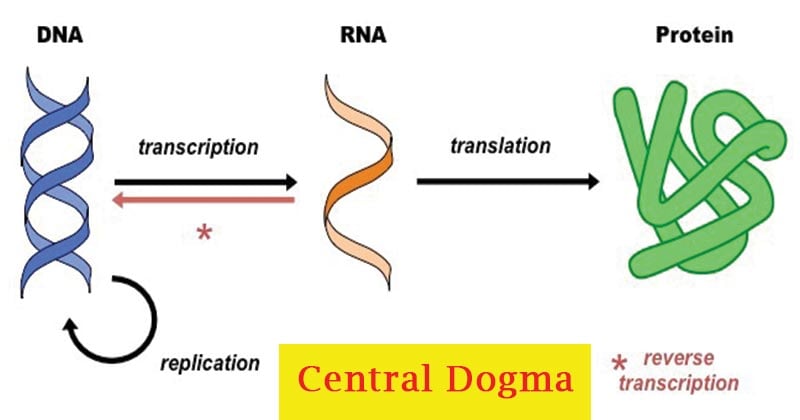- DNA contains the complete genetic information that defines the structure and function of an organism.
- Proteins are formed using the genetic code of the DNA.
- Conversion of DNA encoded information to RNA is essential to form proteins.
- Thus, within most cells, the genetic information flows from – DNA to RNA to protein.
- The flow of information is followed through three different processes which are responsible for the inheritance of genetic information and for its conversion from one form to another:
- Replication: a double stranded nucleic acid is duplicated to give identical copies. This process perpetuates the genetic information.
- Transcription: a DNA segment that constitutes a gene is read and transcribed into a single stranded sequence of RNA. The RNA moves from the nucleus into the cytoplasm.
- Translation: the RNA sequence is translated into a sequence of amino acids as the protein is formed. During translation, the ribosome reads three bases (a codon) at a time from the RNA and translates them into one amino acid.
- This flow of information is unidirectional and irreversible.

This explanation is the simplest way in which the Central Dogma of Molecular Biology is interpreted.
- In the bigger picture, the central dogma of molecular biology is an explanation of the flow of genetic information within a biological system.
- It was first stated by Francis Crick in 1958, as
- “Once ‘information’ has passed into protein it cannot get out again. In more detail, the transfer of information from nucleic acid to nucleic acid or from nucleic acid to protein may be possible, but transfer from protein to protein, or from protein to nucleic acid is impossible.”
Interesting Science Videos
The Dogmas
- The dogma is a framework for understanding the transfer of sequence information between information-carrying biopolymers, DNA and RNA (both nucleic acids), and protein.
- There are 3×3=9 conceivable direct transfers of information that can occur between these.
- The dogma classes these into 3 groups of 3:
A. Three general transfers
- It describes the normal flow of biological information: DNA can be copied to DNA (DNA replication), DNA information can be copied into mRNA (transcription), and proteins can be synthesized using the information in mRNA as a template (translation).
- It is believed to occur normally in most cells.
B. Three special transfers
- The special transfers describe: RNA being copied from RNA (RNA replication), DNA being synthesised using an RNA template (reverse transcription), and proteins being synthesised directly from a DNA template without the use of mRNA.
- Temin (1970) reported the existence of an enzyme “RNA dependent DNA polymerase” (inverse transcriptase) which could synthesize DNA from a single stranded RNA template.
- Baltimore (1970) also reported the activity of this enzyme in certain RNA tumour viruses.
- This exciting finding in molecular biology gave rise to the concept of central dogma reverse” or teminism, suggesting that the sequence of information flow is not necessarily from DNA to RNA to protein but can also take place from RNA to DNA.
- It is known to occur, but only under specific conditions in case of some viruses or in a laboratory.
C. Three unknown transfers
- The unknown transfers describe: a protein being copied from a protein, synthesis of RNA using the primary structure of a protein as a template, and DNA synthesis using the primary structure of a protein as a template
- These are not thought to naturally occur.
Significance of the Central Dogma of Molecular Biology
Thus, the central dogma provides the basic framework for how genetic information flows from a DNA sequence to a protein product inside cells and thus give an insight to the important processes going on inside the cells.
References
- Verma, P. S., & Agrawal, V. K. (2006). Cell Biology, Genetics, Molecular Biology, Evolution & Ecology (1 ed.). S .Chand and company Ltd.
- https://users.ugent.be/~avierstr/pdf/principles.pdf
- http://www.csun.edu/~cmalone/pdf360/Ch14-1gen%20code.pdf
- https://en.wikipedia.org/wiki/Central_dogma_of_molecular_biology.

Thank you so much! I love ur blog.
wow it’s just a wow
Good exposition but then it seems that the central dogma fails only under an unnatural circumstance. This allows scientists to provide or create an unnatural environment to archive a desired end, especially in drug discovery or fight against cancer and such deadly disease.
Good notes provide